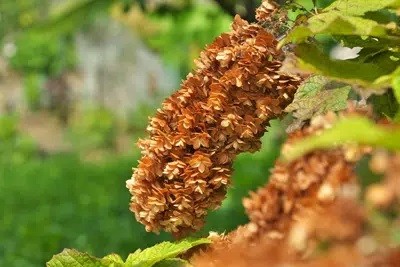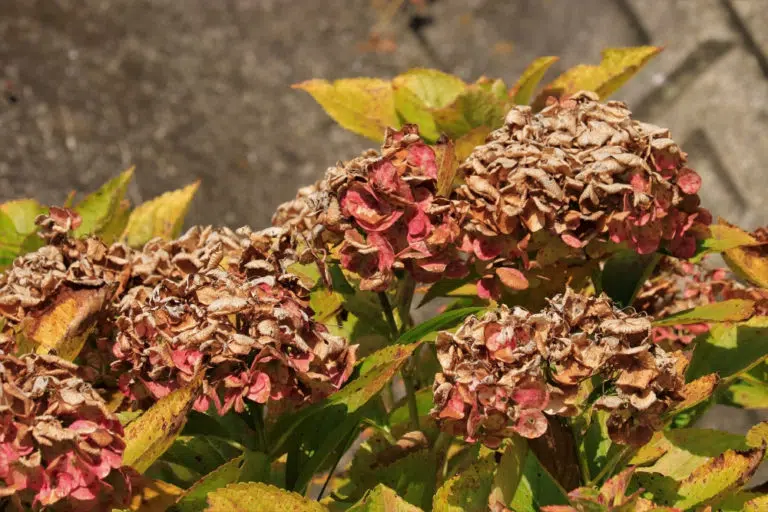If your hydrangea leaves and flowers drooping, panic is great. The popular ornamental plants are extremely hardy and can be quickly nursed back up by you with the appropriate measures.
Lack of water
The most common cause of drooping leaves and flowers on hydrangeas is a lack of water. Hydrangea species are among the thirstiest shrubs in the garden and depend on sufficient amounts of water so that they do not dry out. Initially, lack of moisture does not affect the vitality of the plants, and with an appropriate addition of water, the condition can be remedied. A lack of water can be recognized by the following signs in addition to drooping foliage, flowers or buds:
- Plant parts suddenly wilt
- color does not change
- dried out substrate
Above all, the timing is crucial here. If the condition occurs not over a long period of time, but literally overnight, the plant is too thirsty. In the case of planted specimens, it is enough to give the site a good sponging with the garden hose. If you have potted plants, proceed as follows:
- Fill bucket with low-lime water
- Carefully detach the plant from the bucket
- Do not separate root ball from soil
- check roots
- remove dried roots
- Immerse root ball in water
Leave the plant in the water until no more air bubbles rise from the root ball. It has now completely soaked up water and can be repotted. In the following weeks, you should check the substrate or the outdoor location for dryness. The thumb test is the best way to do this. Don’t be surprised that your hydrangea may dry out again just a few days after providing water. Hydrangea plants (Hydrangeaceae) are very thirsty and therefore need to be watered regularly as needed.

Waterlogging
If the flowers or leaves are drooping on your hydrangea, it doesn’t always have to be related to drought. Another possibility, which is much more dangerous for the plant, is root rot. It is triggered by waterlogging, which is not at all good for the otherwise thirsty plants. You can tell if you have watered too much by the following signs:
- wet substrate
- leaves drooping
- yellowish discoloration possible
- formation of flower buds is reduced
- flowers droop
- Scanty growth
When the scab growth has set in, the hydrangea is difficult to save, because much of the roots have died due to rot. Accordingly, as soon as you notice wilted leaves and it is not too hot, you should check the location for too much moisture. Waterlogging is more common in potted plants than in planted hydrangeas. If waterlogging is really the cause, you must act quickly to save your specimens. To do this, you’ll need to expose the root ball or remove potted hydrangeas from their pots. Once you have access to the roots, follow these steps:
- Check roots
- remove dried, rotten and dead roots
- remove rotten substrate
- create drainage
- drainage material: gravel or sand
- fill up with suitable substrate
- Substrate should be loose and well-drained
If you have a potted plant, the planter must necessarily have drainage holes. This is the only way to guarantee that waterlogging will not occur again. Depending on the substrate used, it may help if you administer a little fertilizer and water the plant only carefully at first.
Wrong location

In addition to water problems, leaves and flowers often droop due to incorrect location. Especially this affects hydrangeas in the tub. The biggest problem here is a place that is too sunny. The leaves evaporate much more moisture, which in turn can lead to drought stress and sunburn. If it becomes too much for the hydrangea because of the location, it will first drop the flowers and then the foliage. It should be as follows:
- Light requirement: semi-shade, off-sun is tolerated.
- no direct midday sun
- preferred orientation: north, west
- protect from drafts
- for potted plants avoid heating floor or wall materials (e.g. tiles)
While potted plants can be easily moved, this is not the case with planted specimens. Hydrangeas are very loyal to their location and become established in it after only a short time. Transplanting is no longer possible without damaging the plant. In this case, need to establish a shelter from the midday sun or drafts. Suitable are:
- Sunshades
- Install awning
- Erect pergola
- Awning
Similarly, you can protect hydrangeas from the sun with a larger tree. This is planted nearby and should block the midday sun well enough once it reaches the necessary size. Optional climbing or hedging plants can be planted nearby over an arch or trellis.
Late frost damage
More rarely, late frosts can cause wilting of the foliage. Especially in April or May, at the latest until the Ice Saints, accidental frosts are a problem. However, if the young leaves suddenly wilt in the spring after a cold night, you do not need to worry about the plant, because it should recover without any problems. The important thing here is to regularly check the shoot tips for frost damage, as compared to the leaves, they are not easily replaced by new foliage. You need to cut off damaged shoots down to the next pair of buds so that they can sprout anew. Frozen and thus drooping foliage, on the contrary, does not play a role in the health of the hydrangea.


